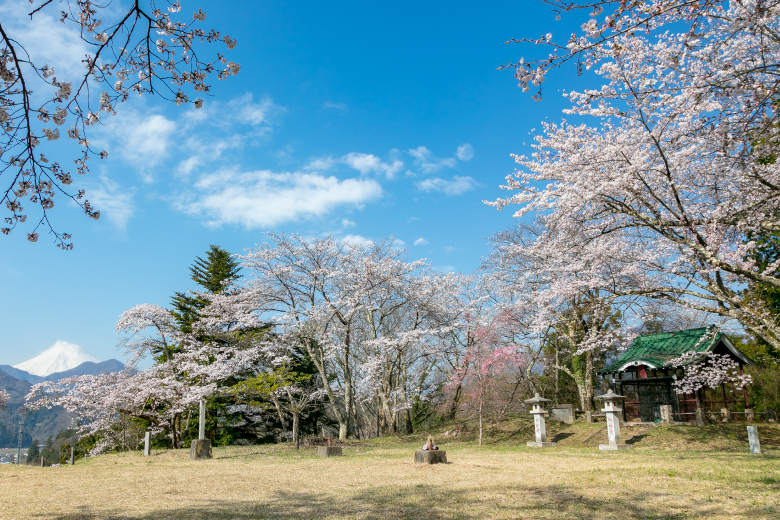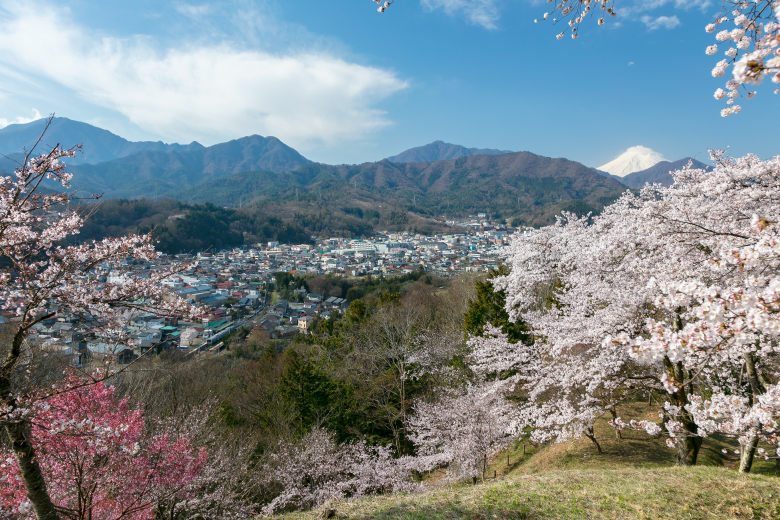Katsuyama-jo Castle stood atop a mountain that rises high behind Katsura River. According to Kai Kokushi (Official Records of Kai Province), an Edo Period compilation of regional topographical information, it was built in 1594 by Asano Ujishige, the ruler of Gunnai at the time. Recent studies suggest that it was actually built as a fortress by the Oyamada rulers of Gunnai when they relocated their residence to Yamura. After the downfall of the Oyamada Clan, a succession of other clans ruled the region from the Warring States Period (1467–1603) to the Edo Period (1603-1868), including the Torii Clan, Miwa Clan, Asano Clan, Torii Clan again, and Akimoto Clan.
During the Edo Period, Uji tea to be offered to the Shogunate was temporarily stored in the tea cellar at Katsuyama-jo Castle after being transported via the Nakasendo, Koshu Kaido, and Yamura-ji(Fuji-michi) Roads. Hence, Fujimichi Road was also called “Chatsubo-ji” (literally, “tea jar road”) and “Chazuke-ji” (literally, “green tea rice road”).
The site of Katsuyama-jo Castle ruins offers a magnificent panoramic view of the entire city of Tsuru and Mount Fuji.
During the Edo Period, Uji tea to be offered to the Shogunate was temporarily stored in the tea cellar at Katsuyama-jo Castle after being transported via the Nakasendo, Koshu Kaido, and Yamura-ji(Fuji-michi) Roads. Hence, Fujimichi Road was also called “Chatsubo-ji” (literally, “tea jar road”) and “Chazuke-ji” (literally, “green tea rice road”).
The site of Katsuyama-jo Castle ruins offers a magnificent panoramic view of the entire city of Tsuru and Mount Fuji.
COURSE MAP
Where to next?
Visiting Natsugari, the town with pure spring water from Mount Fuji
Pure spring water used to make Gunnai woven fabric is also good for your body and soul.
The Road to Mount Fuji (Fuji-michi) runs parallel to the National Route 139 toward the south and separates to the right from the national route after the Toka-ichiba area toward the Natsugari area.
Included in the 100 Best Natural Waters in Japan by the Ministry of the Environment, Toka-ichiba – Natsugari Natural Springs is a blessing from nature from the foot of mountains filtered over a long period of time after the rain and snow that fall on Mount Fuji soak into the ground. Spring water coming from more than 10 sites maintains a temperature of approx. 12 to 13 degrees C throughout the year. It is used for the cultivation of mizukakena (Brassica rapa variety) and horseradish as well as for tap water in Tsuru City. The water and lava from Mount Fuji have also produced a wide variety of beautiful nature. Countless waterfalls flowing down like a shower curtain, a phenomenon called undercurrent falls, and uniquely shaped rocks are also part of the attractiveness developed by Mount Fuji.
Included in the 100 Best Natural Waters in Japan by the Ministry of the Environment, Toka-ichiba – Natsugari Natural Springs is a blessing from nature from the foot of mountains filtered over a long period of time after the rain and snow that fall on Mount Fuji soak into the ground. Spring water coming from more than 10 sites maintains a temperature of approx. 12 to 13 degrees C throughout the year. It is used for the cultivation of mizukakena (Brassica rapa variety) and horseradish as well as for tap water in Tsuru City. The water and lava from Mount Fuji have also produced a wide variety of beautiful nature. Countless waterfalls flowing down like a shower curtain, a phenomenon called undercurrent falls, and uniquely shaped rocks are also part of the attractiveness developed by Mount Fuji.
about 3㎞ / about 3 hours / on foot

